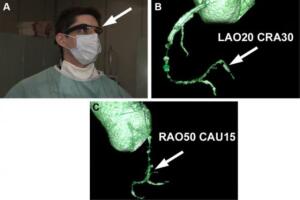por
Lauren Dubinsky, Senior Reporter | November 23, 2015

Couresy of the Canadian
Journal of Cardiology
A group of cardiologists from the Institute of Cardiology, Warsaw, Poland, successfully used Google Glass to guide the opening up of a chronically blocked right coronary artery. Their research was published in the Canadian Journal of Cardiology.
“Mobile technology is easily accessible and affordable, and offers an incremental opportunity to expand the existing open platform for mobile applications, which should in turn overcome the limitations of most advanced angiography systems with dedicated monitors for projection of CTA data sets,” Dr. Maksymilian Opolski of the Institute of Cardiology, Warsaw, Poland, told HCB News.
It’s a major challenge for catheter-based percutaneous coronary intervention (PCI) when a coronary artery is completely blocked. Cardiologists usually have trouble visualizing the occluded coronary arteries with conventional coronary angiography.



Ad Statistics
Times Displayed: 14289
Times Visited: 25 Final days to save an extra 10% on Imaging, Ultrasound, and Biomed parts web prices.* Unlimited use now through September 30 with code AANIV10 (*certain restrictions apply)
Because of that, coronary computer tomography angiography (CTA) is starting to be used more to guide cardiologists when performing PCI. The occluded coronary segment and the distal vessel territory can oftentimes be seen more clearly with coronary CTA versus invasive angiography.
During the procedure, 3-D CTA data sets can be projected on separate monitors in the cath lab, but that is very costly and constrained by space limitations. However, the researchers were able to successfully restore blood flow in the occluded right coronary artery of a 49-year-old man using CTA projections in a wearable virtual reality device based on Google Glass.
The Google Glass device is made up of a wearable, hands-free computer with an optical head-mounted display that the interventional cardiologists wear. The optical head-mounted display can capture and show images and videos while interacting with the surrounding environment.
Opolski doesn’t think that all cardiac and surgical procedures will be aided with wearable computers in the future, but he does believe that procedures that heavily rely on modern imaging modalities including CTA and magnetic resonance tomography will.
“Another potential area where wearable computers might play an important role is remote mentoring that has the potential to enhance medical education and patient safety once widely available,” he said. “We all have this picture in mind when young doctors go to the operating room to pretend to see what the operator is seeing in a small field — a rather tough task for fellows-in-training.”
Back to HCB News

